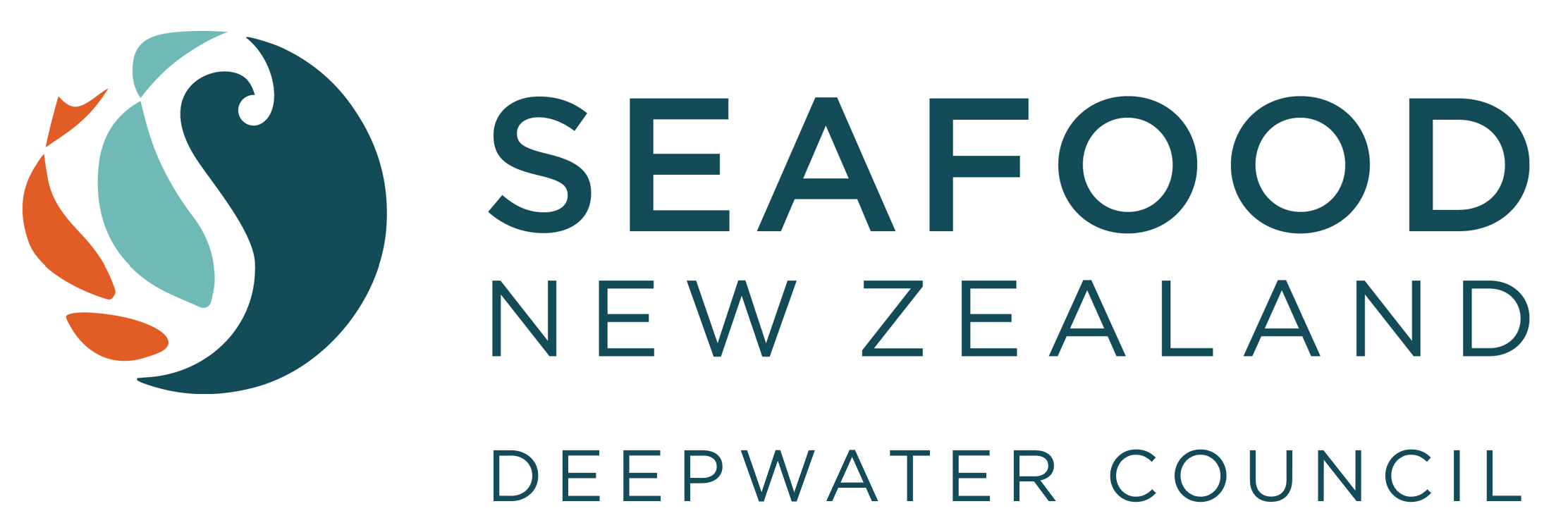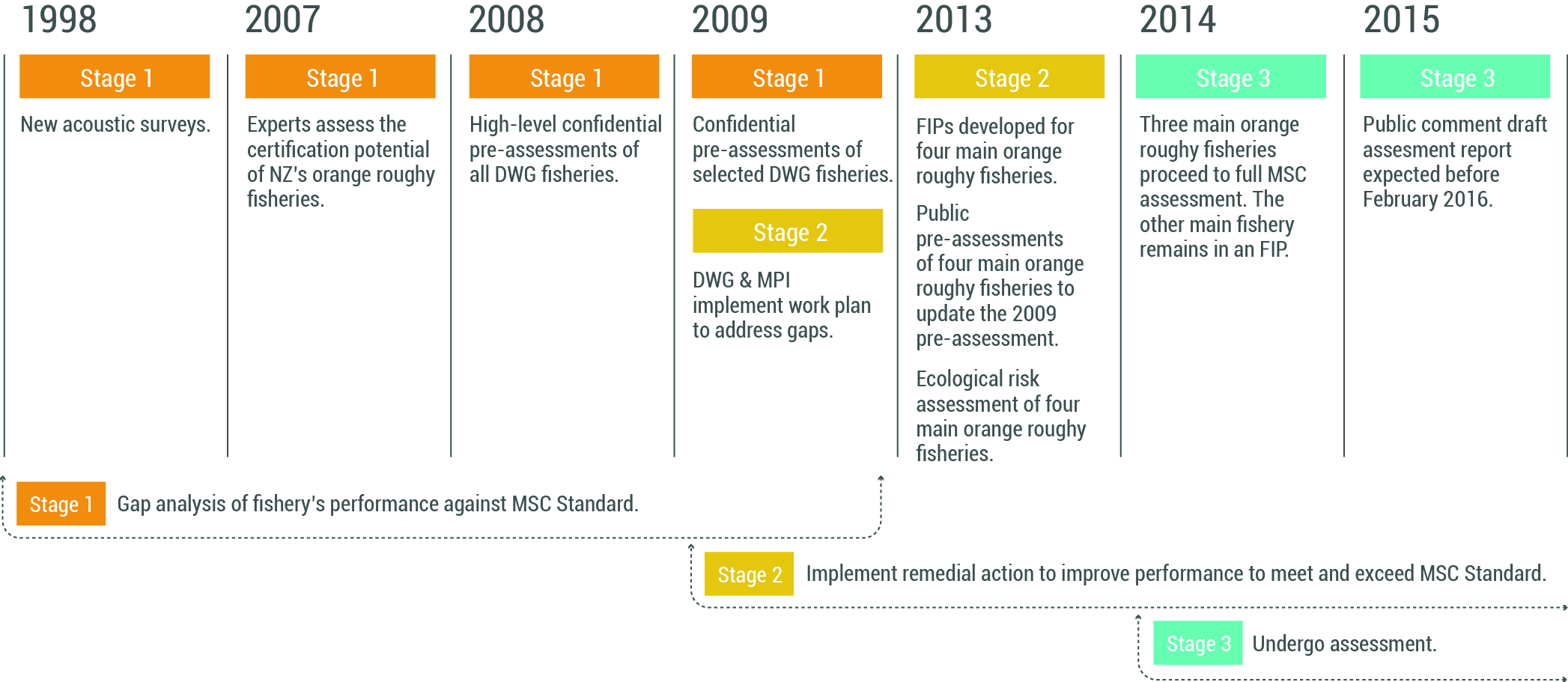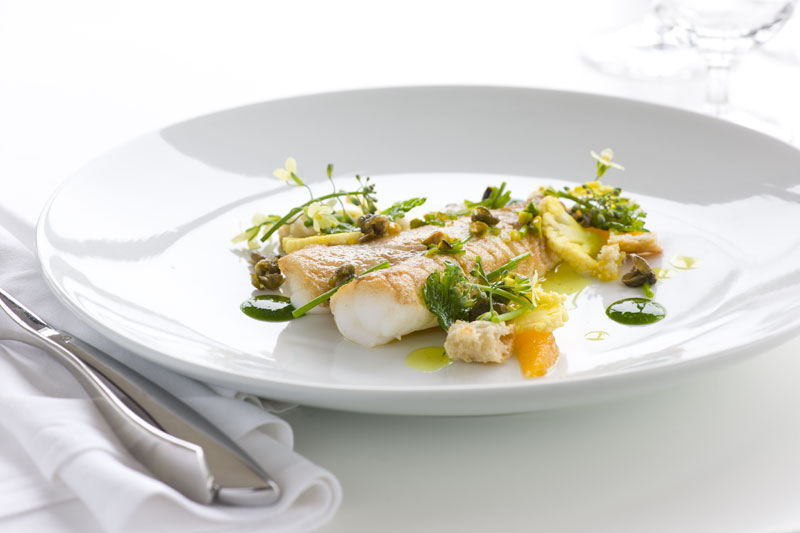Rigorous scientific assessment of orange roughy fisheries in final stage
Published: 20 January 2016
Orange roughy seen from AOS: Being able to see in real time 1,000 m below the surface, scientist can now assess the number of orange roughy with greater certainty.
Deepwater Group welcomes the announcement that New Zealand’s key orange roughy fisheries have now entered the final stage of Marine Stewardship Council (MSC) certification assessment, recognised as the international gold standard in sustainable fishing.
The certification body, MRAG Americas, responsible for assessing the fishery, today published its recommendation that the fishery be certified to the MSC Fisheries Standard. Their draft report for three of New Zealand's key orange roughy fisheries, two on the Chatham Rise and one north west of the South Island, is now available for public comment on the MSC website.
“A team of independent scientists has been assessing the sustainability of these New Zealand orange roughy fisheries over the past 18 months,” says Deepwater Group Chief Executive and Seafood New Zealand Chairman, George Clement.
New Zealand orange roughy certification programme.
In partnership with the Ministry for Primary Industries (MPI), industry has invested heavily over the past 17 years in rebuilding these valuable fisheries through catch reductions, including setting this at times to zero, new scientific techniques to measure and assess stock sizes, and conservative harvest levels. In addition collaboration with Australia’s Commonwealth Scientific and Industrial Research Organisation (CSIRO) since 1998 has led to the development of effective ways to assess the numbers of orange roughy, he says.
Working in partnership with Sealord, CSIRO has developed a world-leading multi-frequency Acoustic Optical System (AOS). The AOS has been used to survey all three fisheries, and was used earlier this year to survey orange roughy stocks off the West Coast of the South Island and south of Fiordland. Being able to see in real time what is going on 1,000 metres below the surface, scientists can now count the number of orange roughy in these fisheries with greater certainty.
The information collected during these surveys is used to estimate future orange roughy numbers by modelling how their numbers will increase or decrease under different catch scenarios, similar to a population census.
These are called stock assessment models, and developing and applying one for orange roughy has been particularly challenging. Earlier models were found to be inadequate, but a revised model has been successfully applied since 2013. The Minister for Primary Industries is using this improved scientific information to set sustainable catch limits.
In the first instance, the focus has been on the three major orange roughy fisheries, which together represent over 60% of New Zealand's orange roughy catch. Industry believe these improved management approaches have been successful. MSC certification will independently verify this success, and then similar approaches will be progressively applied to the smaller fisheries. A fourth fishery (Mid East Coast) is already being prepared for MSC assessment and is in a formal Fisheries Improvement Plan.
These are the first orange roughy fisheries in the world to undergo assessment in MSC’s global programme, which includes evaluation of whether:
- the orange roughy stocks are healthy?
- the fisheries are adversely affecting the marine ecosystem?
- there is ongoing effective management of these fisheries?
“Independent third party verification on the basis of the MSC standard is crucial to evaluate our success in improving the performance of the orange roughy fisheries,” says Sanford Chief Executive, Volker Kuntzsch.
“MSC is the highest internationally recognised standard for sustainable seafood. We are delighted to have reached this stage in their assessment process,” says George Clement.
Over 70% of New Zealand’s deep water catch is currently certified as sustainable under the MSC programme, including the fisheries for hake, hoki, ling, and southern blue whiting.
Quota owners aim to have all New Zealand deep water fisheries performing at, or above, the level that meets MSC’s international standard, and they have implemented a certification programme to achieve this.
“New Zealand’s seafood industry is committed to ensuring the sustainable use of our fisheries and the maintenance of a healthy marine environment. This is good for all concerned, the environment, the consumers, New Zealand, and it’s also good for business,” George Clement says.
“MSC certification gives our customers around the world assurance that our seafood is harvested sustainably. It’s the easiest way for consumers to make an environmental choice when shopping or dining out.”
Pan-fried New Zealand orange roughy with citrus cauliflower salad.
Deepwater Group is a non-profit delivering the vision and leadership to ensure New Zealand’s deep water fisheries are profitable, sustainable, and managed in an environmentally and socially responsible way.
Quick Facts:
- Orange roughy are widely distributed throughout New Zealand and globally in waters between 800 m to at least 1,600 m deep.
- In New Zealand, for every 100 adult orange roughy, less than 5 are harvested each year, leaving at least 95 to ensure healthy stocks for the future.
- Bottom trawling for orange roughy in New Zealand only occurs in small localised areas. Around 0.03% of New Zealand’s Exclusive Economic Zone (EEZ) and 0.2% of the orange roughy habitat range is contacted by orange roughy bottom trawls each year.
- 31% of New Zealand’s EEZ is closed by law to bottom trawling as Marine Protected Areas (MPA). These protect a range of untouched seabed habitats, including:
- 28% of known Underwater Topographic Features (i.e. hills, knolls and seamounts)
- 52% of known seamounts (i.e. those features with elevations of >1,000 m)
- 88% of known active hydrothermal vents.
- All of our fishing crews undergo environmental training to ensure that we can minimise the risks to seabirds and to marine mammals from fishing. Our environmental performance is independently monitored by government observers.
- There are no adverse effects on marine animal populations. Last year, there were no interactions with dolphins, New Zealand fur seals, New Zealand sea lion, and with protected shark species. Interactions with seabirds occur very occasionally. In 2012-13, it was estimated that there were only 11 seabird captures.
- Scientists estimate that 94-98% of the area where protected coral species are likely to occur within New Zealand’s EEZ remains untouched by orange roughy trawls. Between 13-27% of this area where they are likely to occur is closed by law to bottom trawling as MPAs.
- These New Zealand fisheries are the first orange roughy fisheries in the world to be assessed against the MSC standard for sustainable seafood.
- The MSC label provides an easy way to make an environmental choice and to purchase sustainable seafood.
For more information:
Marine Stewardship Council New Zealand orange roughy certification page
Marine Stewardship Council Fisheries Standard Explained
Deepwater Group New Zealand orange roughy certification page
Debbie Hannan
Seafood NZ Strategic Communications Advisor
Office: +64 4 802 1506
Mobile: +64 27 293 2321
Email: debbie.hannan@seafood.org.nz
Sharleen Gargiulo
Deepwater Group Communications Manager
Office: +64 9 379 0556
Email: sharleen@deepwatergroup.org



